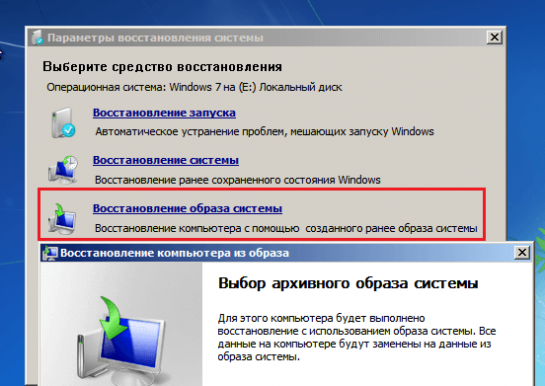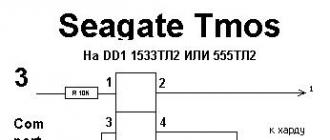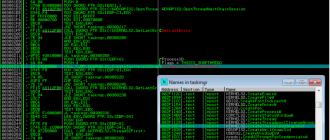During only one Windows startup, the system performs multiple processes. Accordingly, when Windows is not loading, there may be several reasons for this. Below we look at what can cause an error when starting Windows, and also fix the problem.
Hardware problems
We will not dwell on the inoperability of the equipment, since On their own and without the necessary skills, it is not easy to determine which equipment has broken down. Below are some types of errors that indicate that the problem is related to the hardware:
- The repeated failure of the same driver may indicate the inoperability of the device, which is controlled by this driver.
- Errors that are accompanied by the occurrence blue screen can talk about problems with the device’s RAM.
- Various artifacts or a completely missing image talk about problems in the video card.
- If the Windows boot hangs at some stage or doesn’t start at all, it means that it’s not working hard drive.
- If the computer suddenly shuts down during boot-up, it may indicate a power supply failure, motherboardand sometimes other hardware.
Problems with boot file corruption
If the first stages of loading Windows system will detect the absence of important boot files, the message “BOOTMGR is missing” may appear on the screen. In addition, this problem may be accompanied by other messages or by the complete absence of any inscriptions (black screen with or without a cursor).
Bootmgr - operating system loader that is unavailable ordinary users. However, users can easily format it by booting from external media. Thereafter operating system will not load.
Registry issues
If the problem is caused by a damaged registry, then Windows may not even start. Instead, the screen will display a message that the system crashed, and you will also be prompted to use the recovery environment.
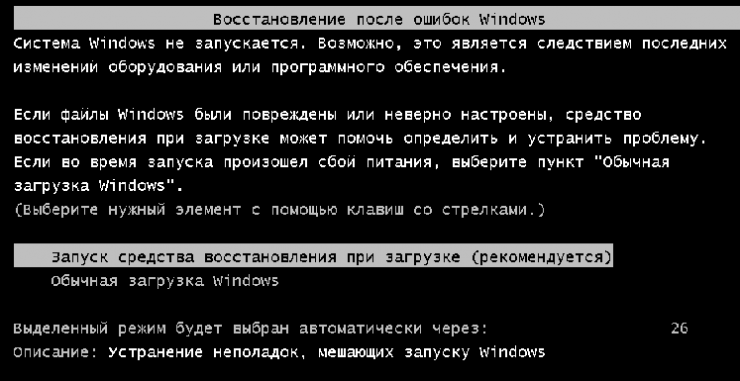
Quite often, recovery helps to load the registry from backup copy and fix windows startup problem.
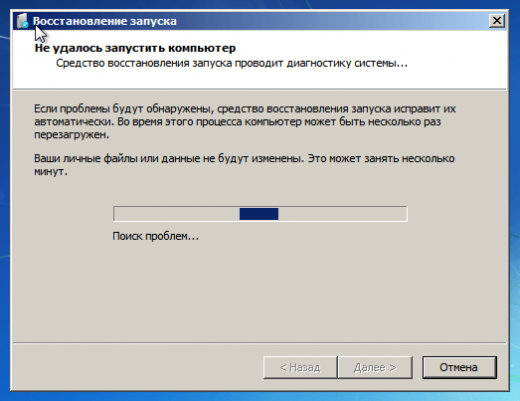
However, recovery may not be successful at all times, because the system may not have the necessary backup copies.
Troubleshooting Windows startup issues
Recovery environment
Starting Windows 7 is much more convenient to resume than Windows XP, which did not have time to get a recovery environment. At installing windowsThis environment is installed on hDD, has a separate partition, as well as a separate bootloader. That is why the recovery environment does not affect the problems faced by Windows.
To launch the recovery environment, press the F8 key and select the “Computer troubleshooting” item from all the Windows startup options.
To get into the recovery environment, the system will ask you to enter a password. If you have forgotten your password or do not have administrator rights, you will have to start the recovery environment from the installation disk.
It is worth resorting to this item if you do not know the exact reason for the absence of Windows startup.
Select "Repair Startup". The system will scan and fix the problems found.

This method can be used if Windows stopped booting after installing the program, virus infection of the computer or registry changes.
The “System Restore” option can help eliminate the problem, but only if the restore points have been saved.

The principle of operation is quite simple: you choose the desired restore point, which is dated from the time when there were no problems with Windows. The system will begin to roll back, after which the normal loading of Windows will occur.
It is used when there are no saved backups on the computer, but you have a recovery point saved on removable media.
Select the “System Image Recovery” option, and then connect removable media containing a system image archive to the computer. Then follow the instructions of the Recovery Wizard.
Manual Registry Restore
Used when the instructions above did not resolve the issue. In Windows, a registry backup is created every 10 days, so you can try to download the latest working backup with your own hands.
- From the list of available options, select "Command Prompt" and type the following command "notepad" into it, then press the Enter key. Will start standard program "Notebook". Select in the program header “File” - “Open”.
- Change directory C: \\ Windows \\ System32 \\ config
- At the bottom of the window in the "File Type" column, change the setting to "All Files" to see the full contents of this folder. The following file list refers to the current registry: Default, Sam, System, Security, Software (without extension).
- Each of these files must be renamed or added to the .old extension.
- In folder "Config" open the folder RegBack. It contains backup copies of the registry. Copy them one by one into a folder. "Config".
- Go back to the window "Recovery Options" and at the very bottom, select the button. If the problem occurs due to a registry failure, then Windows will start up normally.
Recovery of files
Windows has a great utility built in that perfectly recovers protected windows files. On the menu "Recovery Options" select item "Command line" and put the following command in it:
/ scannow / offbootdir = C: \\ / offwindir = C: \\ Windows
Team "Scannow" will run a system scan, "Offbootdir" indicates the letter system disk, "Offwindir" leads to the Windows folder.
Please note that in the recovery environment, drive letters may not coincide with those seen during normal booting windows. Therefore, before starting to scan, be sure to run Notepad (this process is described above) and check the drive letter in the explorer.
Manual file recovery
If the above methods do not bring proper results, you should try to manually restore the boot files, and also overwrite the main boot record Hdd
To do this, open the menu "Recovery Options" – "Command line" and execute the following command, having previously specified the letter of the section through the “Notepad”:
Now execute the following two commands in turn:
After that, resume restarting Windows.
These methods help to eliminate many Windows startup errors. If these tips did not help you, only help remains. service center - The problem may lie in the hardware.
Critical errors when starting Windows 7 occur for a variety of reasons: due to equipment malfunction, due to problems with the system itself or due to failures software. In some cases, a direct relationship of cause and effect can be traced if a failure occurred after installing the application, driver, connecting a new device, etc. In other cases, the source of the error is difficult to determine.
Equipment malfunctions
Problems that arise before the start of loading Windows 7 are related to hardware, so there are literally a couple of words about them. The culprit of the failure can be any of the devices, but most often they are RAM and hard disk. It will help to understand the message in more detail, which is displayed on the screen in case of a critical error.
Every user ever had to see (BSOD). Most of what is written there, we leave behind the scenes, because for the diagnosis we only need the following:
- type of error - the line at the top of the screen written in capital letters through the underscore character (item 1 in the picture);
- error code - a numeric identifier in hexadecimal and its extra options (point 2 in the picture);
- the driver or application that caused the BSOD, as well as the address where the failure occurred (point 3 in the picture). If there are problems with the equipment that arise before the initialization of the drivers and in some other cases this parameter is not present.

The following data may indicate problems with the hard drive or its controller:
- 0x00000077 - KERNEL_STACK_INPAGE_ERROR
- 0x0000007A - KERNEL_DATA_INPAGE_ERROR
- 0x0000007B - INACCESSIBLE_BOOT_DEVICE
- 0x00000024 — NTFS_FILE_SYSTEM
- 0x0000008E - KERNEL_MODE_EXCEPTION_NOT_HANDLED
Memory errors often make themselves felt with such messages:
- 0x0000002E - DATA_BUS_ERROR
- 0x00000050 - PAGE_FAULT_IN_NONPAGED_AREA
- 0x00000077 - KERNEL_STACK_INPAGE_ERROR
- 0x0000007A - KERNEL_DATA_INPAGE_ERROR
- 0x0000012B - FAULTY_HARDWARE_CORRUPTED_PAGE
- 0x0000007F - UNEXPECTED_KERNEL_MODE_TRAP
- 0x0000004E - PFN_LIST_CORRUPT etc.
Often, the failure of RAM is manifested by a variety of errors that can occur at any time during the launch and operation of the computer.
Repairing a simple hardware crash often helps BIOS setup to the default settings or, as they say, reset to default. This can be done in several ways: using your own BIOS option, by switching a special jumper to the mat. motherboard or temporary blackout of CMOS chip (BIOS storage).
To restore the BIOS Setup settings by default using its own option, you need to:
- enter the menu by pressing immediately after turning on the machine a dedicated key (F2, F4, F12, Delete or others - this is written at the bottom of the screen of the motherboard's splash screen);
- open the Exit tab (usually), set the cursor on the LOAD BIOS DEFAULT option (in some versions it is called LOAD SETUP DEFAULTS or LOAD FAIL-SAFE DEFAULTS) and press Enter;
- press F10 and Yes (or Y) to exit and save the settings.

Other ways are switching a special jumper for bIOS reset to CLR CMOS position (name options are CCMOS, Clear CMOS, Clear CMOS, Clear RTC, etc.) or temporary removal of the battery on the board. On some mat. boards for this there is a special button.
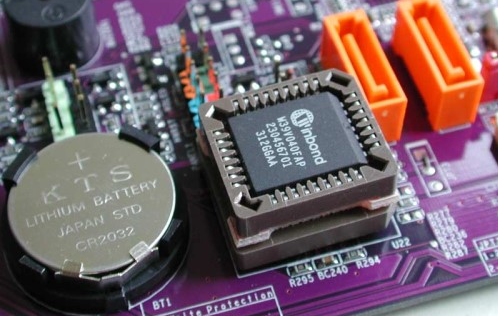
If the method did not help, the failure is probably more serious and is related to the failure of any of the devices. At home, you can try to find the problem node by disconnecting or replacing with a similar serviceable one. If this is not possible - you need to contact the experts.
Using Safe Mode Windows 7
In some cases, failure to start occurs only in normal mode, and in safe mode ( safe mode) system boots without problems. If this is your case - use this opportunity.
To get into safe mode, before starting Windows, press the F8 key several times. When you see such a list on the screen, select the necessary item from it:

After downloading the desktop, you need to open Start, go to the "All Programs" menu, open the "Standard" folder, then "System Tools" and select "System Restore" from there.

This Windows 7 tool will help to fix startup errors caused by damaging the registry, deleting or damaging important files, installing faulty drivers, virus attacks and other things related to the system and software.
- After launching "Restore" you need to select a control point that was created no later than the date when the failure occurred, and then click "Next."
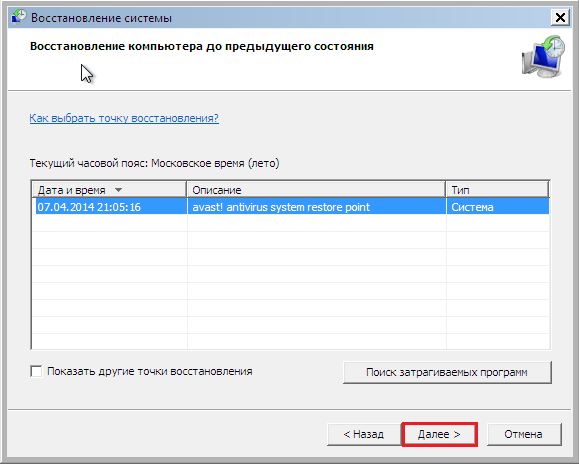
- After confirming the point selection, click “Finish” and wait for the “Restore” to complete its work. This will return Windows 7 to the state it was in before the loading errors occurred. The registry, files, drivers, updates, programs installed or modified after this date will be deleted or returned to normal. Files in user folders will not be affected.
Additionally, you can use the automatic search for problems and their solutions. For this:
- boot into safe mode with network driver support;

- open the Control Panel, select from the "Settings Settings" section "System and Security" and in it "Check the status of the computer."
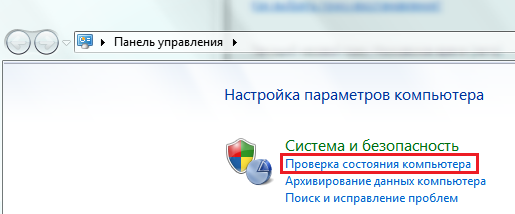
- Expand the “Maintenance” tab and in the “Search for solutions for the problems indicated in the reports” section, click “Search for solutions”.
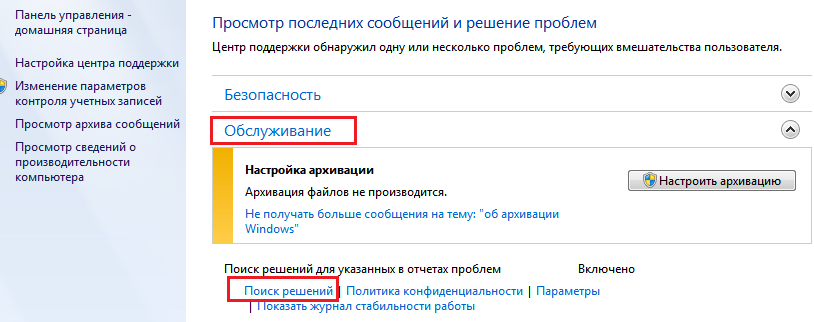
In some cases, the system creates error reports that are sent to the center. microsoft support. If there is a ready solution for your problem, you can use it.
Recovery environment
If the system does not boot into safe mode, if the recovery tool does not find any checkpoint or does not work, another possibility remains - Windows RE. Windows RE is an add-on to Windows 7, a recovery environment that works regardless of whether the main system is booted or not. Tools built into Windows RE allow you to:
- fix problems that prevent the PC from starting normally;
- undo recent changes by rolling back a checkpoint;
- check RAM using Windows 7;
- restore the system from an archive image if it was previously created;
- run a scan and repair tool system files sfc to conduct hard check disk run anti-virus utilities, registry editor, etc.
To get into the Windows RE environment, you need to select the “Computer troubleshooting” item from the F8 menu.

Reaching the window "Recovery Options" you will be able to select the desired tool.
Startup recovery
To identify and fix problems due to which Windows 7 does not boot, select the first option from the list of options: “Startup Recovery”. This tool will automatically check and correct the MBR (Master Boot Record), the state of those responsible for loading partitions in the registry and system files. Most often, errors when starting with Windows 7 are successfully solved with it.

If restoring the launch did not help solve the problem, you can use the same familiar tool to undo the latest changes - System Restore. It happens that it does not see any control point, but in windows environment RE - sees.
To run this tool in the "Recovery Options" is the second top item.
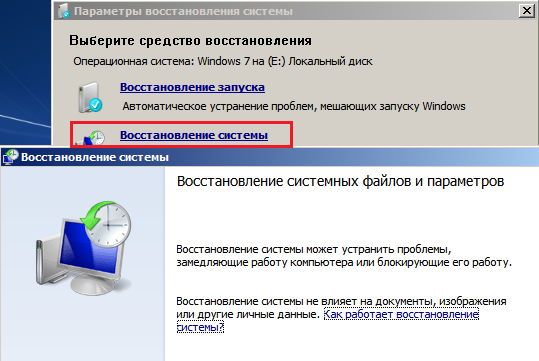
If you have an archive image created during the stable period windows health and programs, you can perform a recovery from it right here. To do this, connect the drive with the image to the computer, select the third item “Restore the system image” from the list of recovery options and follow the instructions of the wizard.

Parameter "Diagnostics windows memory"Help identify problems with random access memory under suspicion of her malfunction. Above, we have listed what errors when starting the computer can be a sign of problems with RAM. It is possible that just because of them, your system does not boot.
In addition to memory failures, problems during startup can be caused by the hard disk, or rather, errors file system and broken sectors. The recovery environment also allows you to search for such problems and fix them. For this through command line need to run system utility chkdsk with the / f and / r options, which means to search for and fix errors, as well as restore the contents bad sectorsand wait for the results. User intervention in this procedure is not required - it is completely automatic.
And finally - if you suspect that the system does not boot due to virus infection, the recovery environment allows you to run anti-virus tools.
To do this, run the command prompt, and through it open the explorer.
- Enter command in command line notepad and press Enter to open notepad.
- Using the “File - Open” menu, launch Explorer - note that in the recovery environment, the drive letters sometimes do not match the letters when booting Windows in normal mode.
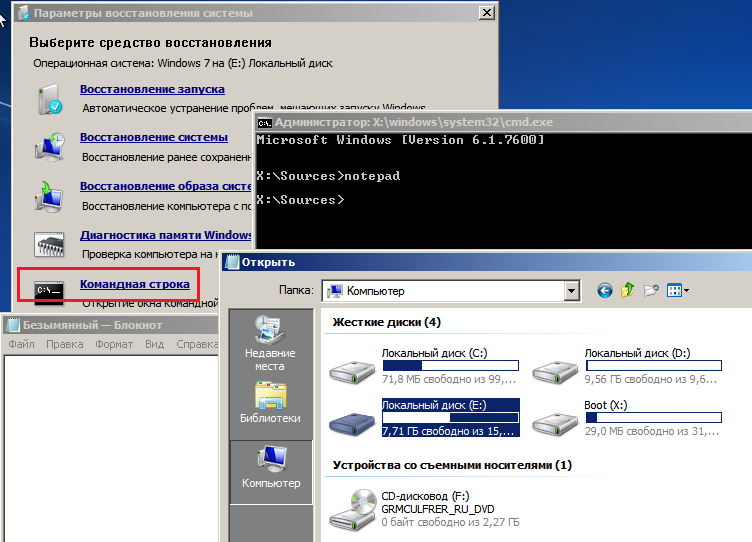
- To see the entire contents of the directories, in the "File Type" field, check "All files".

- Navigate to the folder where antivirus program, for example, the CureIt.exe utility, and run it.
After that, restart the computer. It can be argued with a high probability that the next stratum of Windows will be successful.
This article describes the way to fix the error. boot diskanswering that.
Hello. I think a lot of those who have ever encountered the problem of running Windows and trying to fix it with the help of a boot disk or the system itself:
stumbled upon a recurring message stating that the launch recovery tool is powerless. Practically no resource familiar to me offered any intelligible solution to this problem. And, except to send the user to reinstall windows, do not advise anything.
I offer you a solution to fixing some records. windows registrywhich cause a circular failure of the recovery tool. In general, the principle is simple - we will substitute in a non-working copy of Windows files from the registry backup. In fact, we will do what Windows itself is trying to do - only we will do it manually and for sure. Works on any of windows versions. Or does not work ...
Some of the programs recently installed will have to be sacrificed.
BEFORE YOU BEGIN.
- i hope that you have already used all the means; some help a lot Last configuration with workable parameters
- try to follow the advice carefully, otherwise after reckless actions other means will be completely useless - the system will be beaten really irrevocably
- i do not give guarantees, but it is worth checking
On board:
- bootable disk or flash drive Windows (if the firmware does not work)
- battered and unable to windows startup on computer / laptop
Run the launch recovery tool.
Apparently, since you are reading this article, repeatedly. Once again we stumble upon a message that
Startup Repair Tool cannot automatically repair this computer.
Windows cannot automatically troubleshoot this computer.
and go for more tools to work in Show advanced system recovery features. We need a command console:
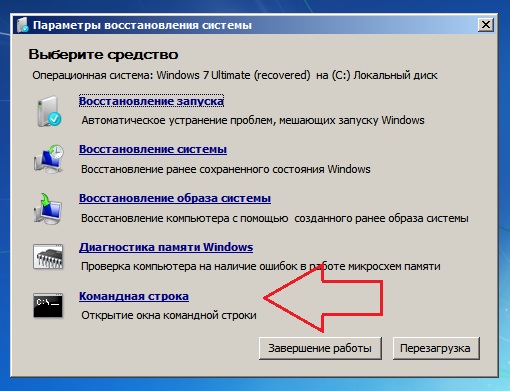
The console will open from X. Let me remind you that this is exactly the letter of the carrier on which the Windows boot (installation) files are located. Let's move to the section with the installed system. This is usually section C. If there are several partitions, and even more systems, you have to navigate by the space occupied, the directories, accounts. But in this case, Windows installation at installation is usually enough for letters C and D.
- enter the required disk with the command in the following manner:

i turned out to be a system drive D
- check its content. The fastest way to do this is to enter the command:
if there were folders in the manner Program files, Desktop and others, you are in the right place.
- go to the Windows system directory:
where we will display its content again for better navigation with the dir command and withlet's create a folder containing files with which we will work (in case something goes wrong). I called the new folder backup - the name is arbitrary:
Md backup

- and copy all the contents of the directory into this folder:
 If the first attempt fails and you have to rewrite the content, in response to a console question, press A.
If the first attempt fails and you have to rewrite the content, in response to a console question, press A.
ATTENTION. At this stage, no errors should happen to you. If something goes wrong, repeat the work from the beginning step by step.
- We are now interested in the contents of the RegBack folder:
Its content is almost the same for all users and looks like this (dir command to help):

The main thing is that there should not be empty folders with contents of 0 bytes.
- Copy the contents of the RegBack folder with the command (follow the syntax):
and pressing on Enter will copy the contents to the directory from where the folder is viewed (Windows \\ System32 \\ config). If the console requires confirmation, press Y or A.
- Close the console and reboot.

